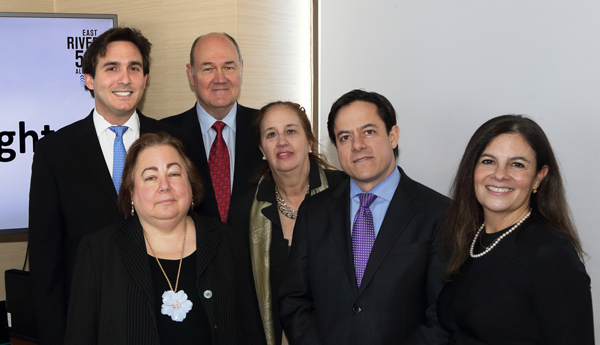(Editor’s note: After this story was published, the city cut a deal that would restrict the scale of the tower at Sutton Place. See that story here.)
From the outset, 3 Sutton Place was a minefield — a development site mired in high-interest debt for one of the tallest planned luxury towers on the Upper East Side. That set the stage for a drawn-out real estate battle in the upscale enclave.
For nearly three years, the site has been riddled with controversy: a bankruptcy, a contested foreclosure and now a community-led fight to dramatically alter plans for the location.
Gamma Real Estate, the project’s lender-turned-developer, emerged victorious last year when it won the site at foreclosure after bidding $86 million and paying another $12 million for air rights. The property, previously owned by Joseph Beninati’s Bauhouse Group, contains just over 260,000 buildable square feet, and Gamma plans to use virtually all of it, having filed plans for an 800-foot tower.
But the site’s future is threatened by recent efforts to rezone 11 blocks in the area, which is currently free from height limits. A group of residents and local officials are seeking to cap the heights of new luxury buildings at 260 feet — a proposal that would reduce Gamma’s by more than 65 percent.
The developer is now in a high-stakes race to complete its foundation work before the opposition group, East River 50s Alliance (ERFA), can convince the City Planning Commission to approve the rezoning.
“It’s so crazy to us that we’re even in this position,” Jonathan Kalikow, Gamma’s co-founder and president, told The Real Deal. “Although [the rezoning] is an out-of-the-box risk, it’s a risk that could be very detrimental to the project.”
Not only that, but Gamma has little experience as a ground-up developer in New York City. So even if the company succeeds in beating the rezoning proposal, constructing a luxury supertall would potentially be another hurdle. One recurring rumor — in media reports and among those who oppose the project — is that Gamma does not plan to actually build the tower and will sell the property once the foundation is set.

Jonathan Kalikow
Kalikow said that although his company received several offers in late 2016 from “bottom feeders” looking to scoop up distressed assets, he has no active plans to sell the property.
Still, the sputtering luxury market could make it difficult for Gamma to sell either the condo units or the undeveloped site.
“The super-high-end market is suffering big time,” said Eric Anton, an investment sales broker at Marcus & Millichap. “I think they can potentially lose a lot of money here.”
Ticking time bomb
Bauhouse purchased three apartment buildings at the site — located at 428, 430 and 432 East 58th Street — for $32.5 million in January 2015. The little-known developer planned to build a nearly 1,000-foot-tall luxury condo tower on the site, designed by international architecture giant Foster + Partners. Over the next two months, Gamma provided $147 million in debt lumped with a $45 million exit fee — meaning the effective interest rate on the loans amounted to about 30 percent.
Within a year, the borrower and lender were at odds.
Though Beninati told Gamma that a handful of Chinese companies were clamoring to infuse “several hundred million dollars” into the project, Bauhouse failed to secure enough funding for the entire development or even refinance its existing loans, according to a March 2016 filing by Gamma in the bankruptcy case. By January 2016, Bauhouse defaulted on the financing and sued Gamma to prevent the lender from foreclosing on the property. When that didn’t work, Beninati filed for Chapter 11 bankruptcy to block Gamma’s takeover of the project. That failed, too.
In July 2016, Beninati filed another lawsuit against Gamma, alleging the company’s chairman and CEO, N. Richard Kalikow, conspired with his cousin Richard R. Kalikow, a real estate attorney at Herrick Feinstein, to take control of the property. Richard Kalikow was Beninati’s lawyer for the project at 3 Sutton Place, and the lawsuit accused the cousins of swapping insider information as part of a 15-month-long “calculated scheme” to kick Bauhouse off the project.
A bankruptcy court judge threw out most of Beninati’s claims last November, but Bauhouse filed a second suit against the law firm last month with similar claims that it took part in a “loan to own scheme.”
“The facts clearly show that Beninati is trying to cast blame for his failed development project wherever he can, by shirking his financial obligations and lashing out at various parties involved,” a spokesperson for Herrick Feinstein said in a statement.

From left to right: Council member Ben Kallos, state Sen. Liz Krueger, ERFA Co-chair Robert Shepler, Manhattan Borough President Gale Brewer, Council member Daniel Garodnick
and ERFA Communications Director Lisa Mercurio.
The bankruptcy court judge ruled this January that Beninati and two other principals on the project, Christopher Jones and Daniel Lee, were personally on the hook for more than $24 million because of personal guarantees they signed on the loans. Representatives for Beninati and Bauhouse could not be reached for comment.
Meanwhile, ERFA proposed its rezoning plan to limit the heights of buildings and create a new inclusionary housing zone that would allow developers to build up to 350 feet if they include affordable units in their projects. The proposal has garnered the support of Manhattan Borough President Gale Brewer, City Council members Dan Garodnick and Ben Kallos and state Sen. Liz Krueger, but it has not yet received the crucial approval from City Planning.
“We’ve asked for an increase in affordable housing,” said Alan Kersh, the community group’s president and a resident of the Sovereign — a 485-foot-tall co-op across the street from Gamma’s site. “We’re baffled why that’s not getting more attention from the mayor. It’s not about the one project, it’s about the entire neighborhood’s character.”
The group hopes to get the City Council to consider the rezoning before Thanksgiving, Kersh added.
Kalikow said he believes the rezoning proposal is driven by residents of the co-op who are concerned that the new building will block their views of the river, rather than a need for more affordable housing. He maintained that the group and elected officials are unfairly pursuing the campaign against the development even though it’s shorter than the 1,000-foot tower Beninati had proposed. Kalikow also said he largely blames Beninati for the community’s animosity toward the project and noted that Gamma paid $25 million for 57,700 square feet of inclusionary air rights — indirectly promoting the creation of affordable housing.
Kallos, who helped co-found ERFA, said the group is made up of more than 2,000 people across 45 buildings in the area. The Council member said the rezoning effort is spurred by the fact that construction in his district is rampant and residents are seeing very little affordable housing created in the area.
“You can literally walk anywhere in my district and see one construction site from another construction site,” said Kallos, who told TRD that he wanted to step in to prevent “another 432 Park Avenue” from towering over the city. “People in my district are getting development fatigue.”
Race against time
During a July 2016 hearing, an attorney for Gamma commented on the pressing need to move forward with the property’s auction. He cited the rezoning initiative, saying that Gamma would need to demolish the existing apartment buildings on the site and lay a foundation with specific building plans if the project was to escape any zoning changes.
“Time really is becoming — I don’t want to use ‘the enemy,’ but it’s a very adverse factor,” said Adam Rogoff of Kramer Levin Naftalis & Frankel, according to the hearing transcript. “People pay more money, one hopes, to live higher up. And if the community is successful in rezoning, then it means the building can’t be built as was intended and designed.”
A Cushman & Wakefield appraisal of the property in September 2015 found that it would be worth $1 billion once Beninati’s condo project was completed. Leading up to the bankruptcy auction, industry experts speculated that Gamma would pay up to $187 million for the development site. But the company ended up paying $89 million short of that for the site and the air rights.
“It’s a canary coughing in the coal mine solely for the development market,” David Schechtman of Meridian Capital Group, who co-brokered the sale to Gamma, told TRD at the time. “It’s the bellwether for high-end condo developments.”
Kalikow acknowledged that the softening luxury market is on the company’s radar but said he believes the uniqueness of having a waterfront tower on Manhattan’s East Side akin to those at the south end of Central Park will appeal to buyers. And though Gamma has limited experience with ground-up development, the firm has tapped Danish architect Thomas Juul-Hansen to design the tower and construction giant Lendlease to serve as its contractor. Still, Kalikow hasn’t completely ruled out the prospect of selling the development site.
“I’m a very practical commercial person,” he said. “The site’s not for sale. But if someone wants to pay a price that seems reasonable to us, I’m not going to say no. To me, everything is for sale at a price.”
Bob Knakal, chairman of New York investment sales at Cushman, said a ready-to-go foundation and approved design plans are major selling points for a development site. “It’s a huge plus,” Knakal said, noting that any new owners could close on the property and begin building immediately once that’s in place. “When you look at the cost of construction, the most uncertain part is the foundation. Once you start excavating, you don’t know what you’re going to find.”
Kalikow said that while he didn’t have an estimate for how much longer the foundation would take, his team is working fast and efficiently. Asked what Gamma would do if the rezoning were approved before the project’s foundation gets completed, he said that’s “not a contingency we’ve thought about at this point.”
Marcus & Millichap’s Anton pointed to that as another cause for concern. “If you are a developer, you want clarity, you want to know what the hell you can build,” he said. “If there’s the potential of the site being downzoned, how do you pay for it?”
